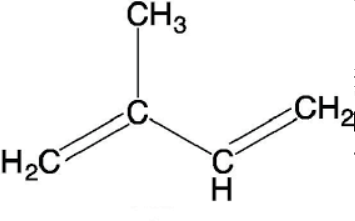
The structure of isoprene is:
a.) \[C{{H}_{3}}-CH=C=C{{H}_{2}}\]
b.) \[C{{H}_{2}}=C(C{{H}_{3}})-CH=C{{H}_{2}}\]
c.) \[CH\equiv C-C(C{{H}_{3}})=C{{H}_{2}}\]
d.) \[C{{H}_{2}}=C(C{{H}_{3}})-C{{H}_{2}}-CH=C{{H}_{2}}\]
Answer
582k+ views
Hint: "Iso" is a prefix, used when all carbons except one form a continuous chain. This one carbon is part of an isopropyl group at the second carbon of the chain. “Iso” sometimes also indicates that the molecule is a constitutional isomer of another molecule with a common name.
Complete step by step solution:
Isoprene is an unsaturated penta-hydrocarbon. IUPAC name of isoprene is 2-methyl-1,3-butadiene. It is a colorless, volatile liquid hydrocarbon having petroleum-like odor. Its chemical formula is \[{{C}_{5}}{{H}_{8}}\], structure is given as \[C{{H}_{2}}=C(C{{H}_{3}})-CH=C{{H}_{2}}\].

Additional Information:
Isoprene reacts very rapidly with hydroxyl radicals, reducing the oxidizing capacity in the atmosphere. This leads to an extended lifetime of greenhouse gases, methane, thus increasing global warming.
Nitric oxide if present in high concentrations, reacts with isoprene and produces nitrogen dioxide. And the formed nitrogen dioxide via photolysis, increases the amount of ozone, which is a greenhouse gas.
Oxidation of isoprene in the atmosphere forms secondary organic aerosols that cause scattering of the sunlight.
Isoprene is an important commodity chemical, currently produced from petroleum, with the potential to serve as an aviation fuel and a feedstock for numerous products, including its polymer, rubber. It is also used to give flavors and fragrances of essential oils and other substances derived from plants.
So, the correct answer is (b).
Note: The precise reactions with Nitric oxide and its effects depend on environmental conditions, such as light intensity and nitrogen oxide concentrations.
Complete step by step solution:
Isoprene is an unsaturated penta-hydrocarbon. IUPAC name of isoprene is 2-methyl-1,3-butadiene. It is a colorless, volatile liquid hydrocarbon having petroleum-like odor. Its chemical formula is \[{{C}_{5}}{{H}_{8}}\], structure is given as \[C{{H}_{2}}=C(C{{H}_{3}})-CH=C{{H}_{2}}\].

Additional Information:
Isoprene reacts very rapidly with hydroxyl radicals, reducing the oxidizing capacity in the atmosphere. This leads to an extended lifetime of greenhouse gases, methane, thus increasing global warming.
Nitric oxide if present in high concentrations, reacts with isoprene and produces nitrogen dioxide. And the formed nitrogen dioxide via photolysis, increases the amount of ozone, which is a greenhouse gas.
Oxidation of isoprene in the atmosphere forms secondary organic aerosols that cause scattering of the sunlight.
Isoprene is an important commodity chemical, currently produced from petroleum, with the potential to serve as an aviation fuel and a feedstock for numerous products, including its polymer, rubber. It is also used to give flavors and fragrances of essential oils and other substances derived from plants.
So, the correct answer is (b).
Note: The precise reactions with Nitric oxide and its effects depend on environmental conditions, such as light intensity and nitrogen oxide concentrations.
Recently Updated Pages
A man running at a speed 5 ms is viewed in the side class 12 physics CBSE

The number of solutions in x in 02pi for which sqrt class 12 maths CBSE

State and explain Hardy Weinbergs Principle class 12 biology CBSE

Write any two methods of preparation of phenol Give class 12 chemistry CBSE

Which of the following statements is wrong a Amnion class 12 biology CBSE

Differentiate between action potential and resting class 12 biology CBSE

Trending doubts
What are the major means of transport Explain each class 12 social science CBSE

Which are the Top 10 Largest Countries of the World?

Draw a labelled sketch of the human eye class 12 physics CBSE

Explain sex determination in humans with line diag class 12 biology CBSE

Explain sex determination in humans with the help of class 12 biology CBSE

Differentiate between homogeneous and heterogeneous class 12 chemistry CBSE




